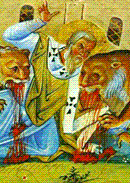Constantine – Pagan Thug Makes Christian Emperor
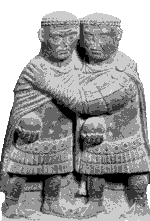
Diocletian (son of a freed slave) supported by Maximian (son of a shop keeper) – a successful partnership that lasted over twenty years.
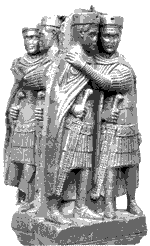
Diocletian and Maximian, now supported by two deputy caesars Galerius and Constantius.
It was the son of the least of them – Constantine – who set his sights on restoring absolute and undivided power.
Diocletian – Son of a Slave Makes Good
Diocletian was the product of merit and of the social mobility which was possible in the late third century.
Diocletian ruled the Roman world for over twenty years. Neither mad nor debauched, he (uniquely) retired from power and famously boasted of growing cabbages “with his own hand” in retirement.
Diocletian had recognised that the empire was too vast for one man’s autocratic rule and had sensibly divided absolute power between four monarchs. At the same time he put in place a mechanism for orderly succession, with the junior Caesars stepping up to the rank of Augustus and appointing deputy Caesars in turn. Moreover, Diocletian had had the wisdom to choose colleagues and successors on the basis of ability and loyalty, not blood-ties. The tetrarchy provided orderly succession for a generation. The provinces themselves were grouped into a dozen Dioceses, each ruled by a Vicar.
Constantine – Pampered Prince Enters the Ring
As caesar of Britain and Gaul, Constantine’s father – Constantius – had been chosen for the most junior post in the tetrarchy. With his promotion, Constantius dismissed his concubine Helena, the mother of Constantine, and made a politically advantageous marriage to the daughter of Diocletian’s colleague Maximian. Constantine himself had been obliged to spend his youth at Nicomedia – as ‘hostage’ in the court of Diocletian.
When the ailing Diocletian stepped down as Augustus after twenty years in 305, Constantine was dismayed that he had been passed over for the position of caesar. Galerius became senior Augustus in the east. Frustrated, and fearful for his life, Constantine fled to Gaul to join his father, and together they campaigned in northern Britain.
Constantius – nicknamed ‘Chlorus’ because of his pale and sickly complexion – died at Eburacum (York) the following year and Constantine was ‘proclaimed’ Augustus by the troops in what was the most marginal of frontier provinces. The ambitious prince was now vulnerable to a charge of usurping imperial authority. His unauthorized promotion was a blow against the Tetrarchy which had stabilized the Roman world. The empire had almost collapsed during the 3rd century because of military rebellions and only a generation before, Aurelian had brought to an end fifteen years of secession by the western provinces. Subsequently, Constantine’s own father had invaded Britain precisely to end a decade of separate imperium in the province under the rebel emperors Carausius and Allectus.
Constantine immediately left Britain and the legionary fortress where he had been acclaimed to establish a firmer base with the legions of the Rhineland. He moved quickly to establish a court in the northern city of Augusta Treverorum (Trier) – often a secessionist capital – but his sights were on a far bigger prize.
Like his father before him, Constantine abandoned a concubine (the mother of his child) to make a politically useful marriage into the family of the senior Augustus (and rival), Maximian, Diocletian’s original colleague, who had returned to imperial politics from an unwelcome retirement. Soon after, Maximian was dead, almost certainly on the orders of his new son-in-law. In the eastern capital an unhappy Galerius reluctantly acknowledged Constantine as a caesar but appointed his own nominee – Severus – as supreme ruler for the west.
In the meantime, Maxentius (son of Maximian and now Constantine’s brother-in-law!) had been proclaimed Augustus in Rome by the praetorian guard. Severus lost his life in an unsuccessful attempt to remove the usurper.
Conversion? My Enemy’s Enemy is My Friend
In Constantine’s day, the eastern provinces were by far the richest and most populous of the Roman world. Some of its cities – Pergamon, Symrna, Antioch and so on – had existed for almost a millennium and had accumulated vast wealth from international trade and venerated cult centres. Through its numerous cities passed Roman gold going east in exchange for imports from Persia, India and Arabia. Flowing west with those exotic imports came exotic ‘mystery religions’ to titillate and enthrall Roman appetites.
In contrast, the western provinces now ruled by Constantine were more recently colonized and less developed. Its cities were small ‘new towns’, its hinterland still barbarian. During the crisis decades of the 3rd century many provincial Romans in the west had been carried off into slavery by Germanic raiders and their cities burned. The province of Britain and part of northern Gaul had actually seceded from the empire in the late third century – and had been ruled by its own ’emperors’ (Carausius, Allectus) with the help of Frankish mercenaries (286-297).
Constantine had no power-base in the east from which to mount a bid for the throne – but he had been at Nicomedia in 303 when Diocletian had decided to purge the Roman state of the disloyal Christian element. He had also served under Galerius on the Danube and witnessed at first-hand how the favoured Galerius – designated heir and rival – in particular despised the cult of Christ.
The ambitious and ruthless prince, from his base in Trier, immediately proclaimed himself ‘protector of the Christians.’ But it was not the handful of Jesus worshippers in the west that Constantine had in mind – there had not, after all, been any persecution in the west – but the far more numerous congregation in the east. They constituted a tiny minority within the total population (perhaps as few as 2%) but the eastern Christians were an organised force of fanatics, in many cities holding important positions in state administration. Some held posts even within the imperial entourage.
By championing the cause of the Christians Constantine put himself at the head of a ‘fifth column’ in the east, of a state within a state.
That Fabulous Fable
At first, Constantine honoured the tetrarchy which had stabilized the empire for a generation but Galerius himself died in 311 and Constantine saw his opportunity. In the spring of 312, in the first of his civil wars, Constantine moved against the ill-fated Maxentius to seize control of Italy and Africa, in the process almost annihilating a Roman army near Turin, and another outside of Rome.
A nonsense repeated ad nauseam is the fable of the ‘writing above the sun’ which advised Constantine of his divine destiny. In its worst form, the legend has it that the words ‘In this sign, you shall conquer’ and the sign of the cross were visible to Constantine and his entire army. The words would have been, perhaps, Latin ‘In Hoc Signo Victor Seris’, a bizarre cloud formation unique in the annuls of meteorological observation.
On the other hand, more than one author (e.g. S. Angus, The Mystery Religions, p236) says that the words were in Greek (‘En Touto Nika’), which would have left them unintelligible to the bulk of the army. Then, again, perhaps they were in both Latin and Greek, a complete occluded front of cumulus cloud!
Digging below the legend however we discover that the vision was in fact a dream reported some years later by Constantine to his secretary Lactantius (On the Death of the Persecutors, chapter xliv; ANF. vii, 318.) The fable was later embellished by the emperor’s ‘minister of propaganda’, Bishop Eusebius, in his Life of Constantine (1.xxvi-xxxi). The ‘sign of the cross’ was an even later interpolation (the cross was not a Christian symbol at the time of the battle – nor would be until the 6th century!). Any ‘good luck emblem’ at this date would have been the chi-rho – ambiguously the first two letters of the word Christos, the Greek word for ‘auspicious’ and also Chronos, god of time and a popular embodiment of Mithras!
What is perhaps most significant about this ‘origins’ fantasy is that ‘lucky charms’ had entered the parlance of Christianity. Constantine did not need to be a Christian; invoking its symbols was sufficient to win divine patronage. But did he invoke its symbols? Coins issued at the time celebrating his victory showed only Sol Invictus: his triumphant arch, still standing, refers only to ‘the gods’. In truth, Constantine was not a particularly pious man. Famously, he delayed his baptism until he was close to death for fear of further sinning – with good reason: among his many murders was that of his first wife Fausta (boiled alive) and eldest son Crispus (strangled).
End of Praetorians: New Germanic cavalry
In the real world, one consequence of Constantine’s victories in 312 was the disbandment of the praetorian guard. The praetorians had had the misfortune to have backed Maxentius and those who had not fallen in the battle (and many had drowned near the Milvian bridge) were demoted and posted to garrisons on distant frontiers.
Replacing the praetorians was a special imperial guard – Scholae Palatinae – an elite cavalry regiment of 500, mainly Germans. Diocletian had pioneered a new force of imperial guards (Ioviani and Herculiani) but these had been crack infantry regiments.
“Constantine’s fondness for German troops led to the charge that he had barbarised the army.” (Farrel, p47)
Constantine’s spite left the city of Rome defenseless – and when the Visigoths arrived a century later – the ‘mistress of the world’ fell to the invader.
Constantine’s Ambition Decimates the Legions
“The feeble policy of Constantine and his successors armed and instructed, for the ruin of the empire, the rude valour of the Barbarian mercenaries … the mortal wound so rashly or so weakly inflicted by the hand of Constantine.”
– Gibbon (Decline & Fall)
Multiple Civil Wars
Having added Italy and Africa to his realm, Constantine at first made secure his position with the senior augustus in the east – where Licinius had succeeded to the throne of Galerius – by a ‘peace pact’ and the gift of his sister as a bride. But within a year, Constantine reneged on his agreement with Licinius and plunged the empire into a new civil war.
Two battles in the Balkans – Cibalae (October, 314), Castra Jarba (November, 314) were stalemated with massive casualties on both sides. It seems Constantine unnerved the Christians in Licinius’s army by displaying Christian emblems in his own legions.
Licinius – an accommodating and benign emperor – sued for a peace in which he acknowledged Constantine as the senior augustus.
Now titular monarch of the world, for a decade Constantine concentrated on wooing the senatorial class in Rome, marked by a program of public works in a city already in decline.
The Fate of Rome
In the embattled years of the late third century the fortunes of the city of Rome began a downspin, even as Christianity’s star was rising.
By Constantine’s day there were about two dozen Christian meeting houses in the city but the imperial court and its bureaucracy had moved north, first to Milan and Trier, and later, to Ravenna and Arles.
Affected both by civil conflict and the recurring epidemics which came in its wake, the city’s population began to fall. Worse yet, at the very moment of Christian triumph – the consecration of the Lateran Basilica by the ‘first Christian Emperor’ – the great general was already well ahead with plans for a new capital, eight hundred miles to the east.
The Christians had plundered and assimilated much of pagan religious thought and ritual; their conquering hero now sequestered the statuary and fabric of the eastern empire to aggrandize his new city on the Bosphorus.
After 326, Constantine never again stepped foot in Rome; he personally ‘never liked the city…’ (J. Norwich, Byzantium, p61).
In consequence the Bishops of Rome picked up the mantle of falling grandeur and set the city on a new Christian path to power.
Autocracy
Having built support within the old imperial capital, and with his ambitions still not satisfied, Constantine provoked yet another civil war with Licinius in 324.
Constantine gathered an army of 125,000 infantry and 10,000 cavalry, and a fleet of 200 vessels. To meet the threat, Licinius stripped troops from the vulnerable Persian frontier to assemble a force of 150,000 infantry, 15,000 cavalry and a fleet of no fewer than 350 ships. Battle was joined at Adrianople on 3 July and Byzantium was blockaded. The fleets met in the Bosphorus, but Licinius’s navy was overwhelmed by a storm, drowning 5000 men in the process. Licinius surrendered on the promise of personal safety; six months later he was strangled by order of Constantine.
The pampered prince had at last reached the summit of his ambition. The tough and ruthless Constantine, bastard son of Constantius and a Bithynian barmaid called Helena, had made himself master of the Empire. Christianity’s hour had come.
Yet in his climb to mastery of the Roman world, ‘the first Christian Emperor’ had brought about the destruction of the heart of the Roman military machine. The huge loss of manpower could be made good only by ever greater recruitment of barbarian detachments, hired as mercenaries to fight Rome’s wars for her.
This, of course, is precisely what Constantine did.
Fatal Reorganisation of the Army
At the height of its power, Rome’s vast empire had been successfully defended by legions stationed in great fortresses on the frontiers. Its military machine had thoroughly mastered the arts of military support and logistics. Some 33 legions had been sufficient to vanquish barbarians in forest, desert, mountain or marsh.
But the legions had increasingly become the makers of emperors. In the interlude of the tetrarchy, Constantine’s father had been chosen by Diocletian for his ability. But Constantine himself had used the Gallic army to stake his own claim for power and he was wary of the legions. Having triumphed by force, Constantine was determined to close the door for any future usurpers.
At the heart of Constantine’s new structure for the army was a mobile field force of 100,000 troops, initially withdrawn from the frontier garrisons. Protection of the imperial regime was more important than protection of ‘remote frontiers’. A mobile force, near to the person of the emperor, replaced forces scattered along thousands of miles of frontier. Up close and personal, potential rivals in the military could be identified and eliminated.
The new army had a new command structure, based upon personal loyalty to the emperor. At its head were two ‘field marshals’ for infantry and cavalry (magister peditum, magister equitum), under Constantine’s watchful eye. Senators were eliminated entirely from military command.
Yet Constantine’s new army proved as disastrous as his new religion.
“The hugh mobile reserve created by Constantine (306-337) fatally weakened the frontier forces and emphasized cavalry at the expense of infantry … Yet in the crucial battles that the legions fought against Goths and Huns it was the clash of foot soldiers – not cavalry – that decided the Empire’s fate.” (Farrill)
The Greek historian Zosimus, in the early 6th century noted other consequences of Constantine’s reforms:
“Constantine abolished security by removing the greater part of the soldiery from the frontiers to the cities that needed no auxiliary forces. He thus deprived of help the people who were harassed by the barbarians and burdened tranquil cities with the pest of the military, so that several straightway were deserted. Moreover he softened the soldiers, who treated themselves to shows and luxuries. Indeed (to speak plainly) he personally planted the first seeds of our present devastated state of affairs.“ (Historia Nova, II.34)
The weakened and demoralised troops who remained on the frontiers (limitarei and ripenses – ‘border’ and ‘river’ guards) were re-grouped into small units of 1000 men (compared to 5000 of the former legions), with limited cavalry support under the command of a ‘dux‘. These small detachments were stationed in hill-top forts, where, essentially, they avoided any engagement with an enemy they were not expected to defeat.
“The limitanei probably went into immediate & gradual decline – the evidence for their tactical deployment is nearly non-existent.”
– Farrill, The Fall of the Roman Empire, p49.
Training for these demoralised and irregularly paid troops seriously declined. Expensive body armour was abandoned, and simple leather caps replaced the iron helmet.
Under such conditions, traditional Roman infantry tactics, driven by harsh discipline and constant training, simply disappeared. The luckless frontier troops, dependent upon payment in rations and only the occasional cash bonus, degenerated into a peasant militia, spending more time in growing food than on the parade ground.
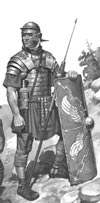
2nd century trooper
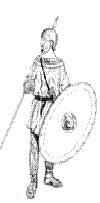
5th century trooper
Yet the expensive mobile force was never mobile enough.
“The result was that Rome’s effective combatant manpower was drastically reduced, even though the overall army was larger than in the earlier Empire.” – Farrill, The Fall of the Roman Empire. p44.
This larger army required a vastly enlarged bureaucracy of tax-collectors and it had to levy the cities annually for manpower. The military draft and rapacious tax collectors sent many cities into a downward spiral as the citizenry seeped away.
Constantine responded to the crisis – plainly evident in his own day – by a law requiring sons of veterans to serve in the army. Military service (like tax collecting) became hereditary. Not only did this precipitate a collapse of espirit de corps: Constantine laid one of the foundation stones of that insidious form of slavery called serfdom.
With the demise of the old structure of the army, the ‘democratic’ escalator, whereby a common soldier, moving through the ranks, could enter the imperial entourage and reach for the throne itself, passed away. The stage was now set for ‘Lords’ on horseback and shoddily equipped conscripts.
Divine, Dynastic Monarch! Strengthening the Centre, Dividing the PeripheryThe wily Diocletian had begun a process (adapted from the Oriental theocracies) which the vainglorious Constantine refined and set as a model for all future monarchs: he surrounded the imperial dignity with a ‘halo’ of sacredness and ceremonial.
A large court-retinue, elaborate court-ceremonials, and ostentatious court-costume made access to the emperor almost impossible. When he eventually reached ‘God’s agent on Earth’, a ‘suppliant’ prostrated himself before the emperor as if before a divinity (Augustus had always stood to greet a senator!)
Henceforth, emperors allowed themselves to be venerated as divines, and everything connected with them was called ‘sacred’. Instead of imperial, the word ‘sacred’ had now always to be used.
The egotistical Constantine, not content with concentrating absolute (and ‘divine’) power into his own hands, went on to reduce the authority of provincial governors and generals (‘duces’, ‘comes’). Some of this authority fell into the hands of the nouveau riche bishops, at whose head stood Constantine himself. Constantine hoped thus to prevent any rebellion arising in the provinces – but he did so at the cost of weakening the ability of provincials to resist invasion.
State Church: Christianity Goes Royal
“Nothing is more welcome to a military empire than a religious doctrine that counsels obedience and acquiescence.“ – Hyam Maccoby, The Mythmaker, p163.
Constantine’s desire to impose upon the Empire a religion that would identify obsequiousness to the deity with loyalty to the emperor found its perfect partner in Christianity – or at least in the Christianity he was to patronize.
In the century before the ignoble alliance of one particular faction with the imperium many christianities had contended. Before Constantine, Christ had, for most Christians, been the ‘good shepherd’, just like Mithras and Apollo, not a celestial monarch or an imperial judge. Nor did the Christian sects dwell on the crucifixion scene:
‘They shrink from the recollection of the servile and degrading death inflicted on their lord, and conceive salvation in the gentle terms of the friendship of Christ, not in the panoply of imperial triumphs.’ (Oxford History, p14)
But with Constantine’s absolute monarchy, Christianity acquired its ‘panoply of imperial triumphs.’ The leading Churchman and propagandist Eusebius hailed the autocrat as a new Moses, a new Abraham. Constantine saw himself, more modestly, as the thirteenth apostle, a saint-in-waiting. At the time, perhaps five per cent of the empire’s population was nominally ‘Christian.’ With imperial encouragement, support, funds and force the Universal Church set about the task of gathering in its flock.
In a number of provinces a serious breach had opened within the Christian churches between those who had ‘apostatised’ during Diocletian’s brief persecution and those who had suffered penalties for their fanaticism. Some churches already had a ‘nationalistic’ bent, serving as a focus for opposition to the emperor.
Constantine, vexed by all such discord, called for an inclusive ‘universal’ or catholic faith. Of course all factions regarded themselves as that universal ‘orthodox’ faith and manoeuvred for preferment. It was inevitable that an autocrat like Constantine would identify with and adopt a church which modelled its organisation not merely upon the Roman State but upon its most authoritarian aspect: the imperial army.
In the Constantinian Church, bishops would rule districts corresponding with military dioceses, would control appointments and impose discipline. Lesser clerics would report through a chain of command up to the local pontiff. ‘Staff officers’, in the guise of deacons and presbyters, would control funds and allocations.
Just as well that in Christian morality there was no place for democracy, only for absolute monarchs, chosen by God. In Christianity there were no human rights (for example, of a slave to his freedom), only obligations (thus a slave should be honest and faithful to his master, because, of course, all would be judged on the day of reckoning).Spoils of Victory: Pillaging the Pagans
The alliance of Roman autocracy and Christian intolerance was a marriage made in hell. The Universal Church eyed with envy the pagan temples and shrines which, through centuries, had amassed their own riches. As propagandists for Constantine, the Christians had the ear of the emperor and successfully urged him to confiscate temple treasures throughout the Empire, much of it redirected to the ‘One True Faith.’
The assault upon the values that had sustained the Empire for a thousand years was merciless and relentless. It began with Constantine’s denial of state funds to the ancient pagan shrines which had always depended on state sponsorship. Never having had full-time fund raisers like the Christian churches the pagan cults immediately went into decline.
But having given the Christians the world, what Constantine could not anticipate was the ferocity of Christian discord, which was to dog his reign and the reign of all who were to follow him.
The Christian ‘community’ itself had changed as a consequence of the Constantinian revolution. Official recognition of Christianity, the tax exemptions it gave devotees and state patronage made the Christian faith considerably more appealing to opportunistic pagans. Episcopal posts became highly sought after when, in 319, the clergy were exempted from public obligations and, in 321, priests were exempted from imperial and local taxation. Clerics were even placed outside the jurisdiction of normal courts (‘Privilegia Ecclesiastica’: Decline of Law).
A flood of new converts, many with little or no religious motivation, swamped the church. Fierce rivalries within the Church multiplied, weakened its power and exposed vulnerabilities in both its doctrine and organisation.
Constantine successfully established the dynastic principle, but it had bitter fruit. His feeble sons, ‘born to rule’, murdered each other (the survivor died falling from his horse). Worse yet, Constantine’s nephew, Julian, though raised as a Christian, detested the doctrine and, on assuming the throne, reversed many of Constantine’s policies.
Emperor Julian on his uncle Constantine
“As for Constantine, he could not discover among the gods the model of his own career, but when he caught sight of Pleasure, who was not far off, he ran to her. She received him tenderly and embraced him, then after dressing him in raiment of many colours and otherwise making him beautiful, she led him away to Incontinence.
There too he found Jesus, who had taken up his abode with her and cried aloud to all comers: ‘He that is a seducer, he that is a murderer, he that is sacrilegious and infamous, let him approach without fear! For with this water will I wash him and will straightway make him clean. And though he should be guilty of those same sins a second time, let him but smite his breast and beat his head and I will make him clean again.’
To him Constantine came gladly, when he had conducted his sons forth from the assembly of the gods.”
– Emperor Julian, The Caesars (c.361 AD)
To the alarm of the new Christian ‘establishment’, the pagan world was not yet ready to die quietly.
Post-Constantine: Lurch into Religious Tyranny
Within three years, Emperor Julian had been assassinated on the Persian front (probably by a disaffected Christian soldier) – but it left the Christians fearful of losing the prize that had fallen so unexpectedly into their laps.Thereafter, the Christians embraced a ruthlessness hitherto unknown in the world, an intolerance which, in the centuries ahead, would wreak unimaginable horror.
In the closing years of the fourth century, draconian laws prohibiting non-Christian beliefs were enacted by the new hero of the Christians, Emperor Theodosius. Heresy was now equated with treason and thus became a capital offence.
Theodosius ‘the Great’ presided over the destruction of temples and icons, the burning of books and libraries, and a rampage of murder of pagan priests, scholars and philosophers. The wisdom and finesse of an entire civilization was sacrificed on the altar of the Christian godman and delivered Europe into a dark age of barbarism and crass superstition.
Only the very brave, the very foolish or the very hidden would now deny their Christianity. The prologue to the Dark Age had been written.
- Edward Gibbon, The Decline & Fall of the Roman Empire (Penguin, 1960)
- Michael Grant, The Roman Emperors (Weidenfield & Nicolson, 1985)
- Michael Grant, The Emperor Constantine (Weidenfield & Nicolson, 1985)
- Arthur Ferrill, The Fall of the Roman Empire (Thames & Hudson, 1986)
- Dan Cohn-Sherbok, The Crucified Jew (Harper Collins,1992)
- Arther Ferrill, The Fall of the Roman Empire (Thames & Hudson, 1986)
- Leslie Houlden (Ed.), Judaism & Christianity (Routledge, 1988)
- Norman Cantor, The Sacred Chain – A History of the Jews (Harper Collins, 1994)
- Friedrich Heer, The Fires of Faith (Weidenfield & Nicolson, 1970)
- H. A. Drake, Constantine and the Bishops: The Politics of Intolerance (John Hopkins, 2000)
- Paul Stephenson, Constantine, Unconquered Emperor, Christian Victor ((Quercus, 2011)
“Diocletian had to know the will of the gods for his campaign in Persia, so he banished the Christians …
They were dangerous, in a position to wreck his staging area and keep supplies from reaching his armies during the war.”
– F.W. Norris, Christianity – A Short Global History, p35.The Jews in 115-117 had come close to sabotaging Trajan’s Parthian campaign
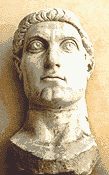
Constantine, egotist supreme
Over 8 feet tall and weighing 9 tons, and that’s just the head!!
Colossal ‘staring’ statues of Constantine signalled the death of realistic portraiture.
“Our emperor, like the radiant sun, illuminates the most distant subjects of his empire through the presence of the Caesars, as with the far piercing rays of his own brightness.
Invested as he is with a semblance of heavenly sovereignty, he directs his gaze above, and frames his earthly government according to the pattern of that Divine original, feeling strength in its conformity to the monarchy of God.
And surely monarchy far transcends every other constitution and form of government: for that democratic equality of power, which is its opposite, may rather be described as anarchy and disorder.“
– Eusebius records his obsequious, anti-democratic drivel.
(The Oration in Praise of Emperor Constantine, 3)

Chi-Rho – on 3rd century BC Egyptian coin!
Between the Eagle’s legs!
Coin issued by Ptolemy III Euergetes (“Benefactor“) 246-221 BC.
Most-favoured
“Constantine did not make Christianity the official religion of the Roman empire, though this is often said of him.
What he did was to make the Christian church the most-favoured recipient of the near-limitless resources of imperial favour.”
– Richard Fletcher, The Conversion of Europe, p19.
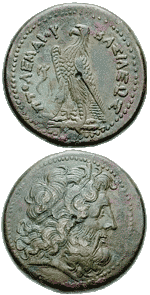
Just Can’t Get the Staff
“Sculpture had fallen so low that in all his empire Constantine could not find a mason capable of decorating his triumphal arch and preferred instead to rob the two-hundred-year-old arch of Trajan.”
– Evelyn Waugh
Halcyon Days
“In the great days of the second century, with an army of 300,000, the Romans defended an empire of 50,000,000 people living in the Mediterranean basin.”
– Arthur Ferrill, The Fall of the Roman Empire, p26.

Arch of Constantine
(Rome) 315 AD
Actually, originally dedicated to Emperor Hadrian.
In order to make the triumphal arch his own Constantine replaced certain panels to honour his victory over Maxentius.
But in truth the monument shows fallen Parthians and a panel with the sun god Apollo!
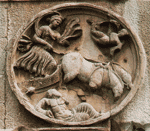
Apollo
Detail from Arch of Constantine
Would you believe it – the Sun God Apollo drives his chariot across the sky!
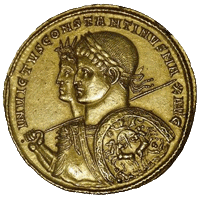
Sol Invictus
Constantine shared his gold coinage with the sun god Sol Invictus at least as late as 317.
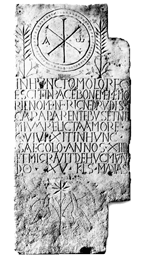
No Cross Here!
6th century Christian gravestone – no cross but the chi-rho monogram (Rheinisches Landesmuseum, Bonn)
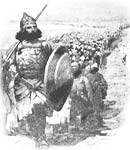
Feeble Policy – Arming Barbarians
Rome’s “hired help” soon dispensed with the effete princes that hired them.

Lucky Survivor!
Marcus Aurelius on horseback – twice life-size and originally gilded to look like solid gold.
Prized exhibit of the Capitol Museum, Rome, it survived papal melting pots only because ignorant clergy thought it had to be their hero Constantine!
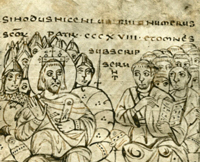
Constantine with his bishops at Nicaea – 325
A 9th century view of “the synod of Nicaea where the number of holy fathers was 318 and all subscribed.”
(MS CLXV, Biblioteca Capitolare, Vercelli, 9th century)

